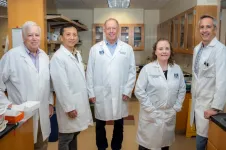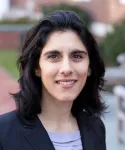(Press-News.org) Eating plant-based foods that contain dietary compounds called flavonols can lower your chances of developing frailty.
Foods like apples and blackberries that contain flavonoids called quercetin may be the most important for frailty prevention.
Approximately 10% to 15% of older adults experience frailty, a geriatric syndrome that leads to a greater risk of falls, fractures, disability, hospitalization, and mortality. Current dietary recommendations for frailty prevention primarily focus on protein intake. However there are many other foods that may have health benefits
“There may be some validity to the old saying, an apple a day keeps the doctor (or frailty) away,” said the authors. “Our findings suggest that for every 10 mg higher intake of flavonols per day, the odds of frailty were reduced by 20%. Individuals can easily consume 10 mg of flavonols intake per day since one medium sized apple has about 10 mg of flavonols.”
“Although there was no significant association between total flavonoid intake and frailty, higher flavonols intake (one of the subclasses of flavonoids) was associated with lower odds of developing frailty. Specifically, higher quercetin intake was the flavonoid that had the strongest association with frailty prevention. This data suggests that there may be particular subclasses of flavonoids that have the most potential as a dietary strategy for frailty prevention,” said coauthor Shivani Sahni, PhD, of Department of Medicine, Beth Israel Deaconess Medical Center, Harvard Medical School, and the Hinda and Arthur Marcus Institute for Aging Research, Hebrew SeniorLife; and Courtney L. Millar, PhD, of the Department of Medicine, Beth Israel Deaconess Medical Center, Harvard Medical School, and the Hinda and Arthur Marcus Institute for Aging Research, Hebrew SeniorLife.
The authors suggest that future research should focus on dietary interventions of flavonols or quercetin for the treatment of frailty. Research is also needed in racially and ethnically diverse participants.
The findings were published in the American Journal of Clinical Nutrition article, "Higher Intake Of Dietary Flavonols, Specifically Dietary Quercetin, Is Associated With Lower Odds Of Frailty Onset Over 12-Years Of Follow-Up Among Adults In The Framingham Heart Study.” This is one of the first community-based studies that comprehensively examined the role of dietary flavonoids for frailty prevention.
Authors are Steven Oei, MSc1,2*, Courtney L. Millar, PhD2,3*, Thuy Nga Nguyen, RN, BSN4, Kenneth J. Mukamal, MD, MPH2, Douglas P. Kiel, MD, MPH2,3, Lewis A. Lipsitz, MD2,3, Marian T. Hannan, DSc, MPH2,3, Shivani Sahni, PhD2,3 .
1Division of Human Nutrition and Health, Wageningen University, Wageningen, the Netherlands (SO).
2Department of Medicine, Beth Israel Deaconess Medical Center, Harvard Medical School, Boston, MA (SO, CLM, KJM, DPK, LAL, MTH, SS).
3Hinda and Arthur Marcus Institute for Aging Research, Hebrew SeniorLife, Boston, MA (CLM, DPK, LAL, MTH, SS).
4University of Arizona, Tucson, AZ (TNN).
*Co-first authors.
Detailed description of the research
This study utilizes data from the Framingham Heart Study – Offspring Cohort to determine the association between flavonoid intake and frailty onset. There were 1,701 individuals included in this analysis. All were free of frailty at baseline and followed from ~12 years to evaluate frailty status (evaluated by the Fried Frailty Phenotype). After ~12 years, 13.2% of the participants developed frailty. Total flavonoids intake was not significantly associated with frailty onset. However, flavonols intake (a type of flavonoid, in particular quercetin) was associated with lower odds of frailty onset.
Funding information or grantor requirements
This study was funded by the National Institute on Aging (NIA) grant number R01 AG051728, the National Heart, Lung and Blood Institute’s Framingham Heart Study (contract numbers HHSN268201500001I and N01-HC 25195). Dr. Millar was supported by the NIA/NIH T32-AG023480 and the Beth and Richard Applebaum Research Fund. Ms. Nguyen was supported by the NIA through the Medical Student Training in Aging Research (MSTAR) Program. DPK was funded by R01 AR041398 and R01 AR061445. Dr. Lipsitz was supported by R21 AG073886 from the NIA. He also holds the Irving and Edyth S. Usen Chair in geriatric medicine at Hebrew SeniorLife. Dr. Mukamal was supported by K24 AG065525.
Conflict of interest statement
Dr. Kiel has received grant funding from Amgen and Solarea Bio. He serves on the scientific advisory board of Solarea Bio Inc., Reneo, and Pfizer, and on a Data Monitoring Committee for Agnovos, and receives royalties for publication by Wolters Kluwer. Dr. Lipsitz is the Editor-in-Chief of the Journal of Gerontology Medical Sciences. Dr. Hannan has received funding to her institution from Amgen, Inc for work unrelated to this project. Drs. Mukamal and Sahni have received grant funding from the United States Highbush Blueberry Council for research unrelated to this project. Dr. Sahni further reports institutional grants from Dairy Management Inc. (ended September 2022) and Solarea Bio Inc. (ended March 2022), has reviewed grants for the American Egg Board’s Egg Nutrition Center and National Dairy Council. Dr. Millar, Mr. Oei and Ms. Nguyen have no conflicts of interest to report related to this current work.
About Hebrew SeniorLife
Hebrew SeniorLife, an affiliate of Harvard Medical School, is a national senior services leader uniquely dedicated to rethinking, researching, and redefining the possibilities of aging. Hebrew SeniorLife cares for more than 3,000 seniors a day across six campuses throughout Greater Boston. Locations include: Hebrew Rehabilitation Center-Boston and Hebrew Rehabilitation Center-NewBridge in Dedham; NewBridge on the Charles, Dedham; Orchard Cove, Canton; Simon C. Fireman Community, Randolph; Center Communities of Brookline, Brookline; and Jack Satter House, Revere. Founded in 1903, Hebrew SeniorLife also conducts influential research into aging at the Hinda and Arthur Marcus Institute for Aging Research, which has a portfolio of more than $85 million, making it one of the largest gerontological research facilities in the U.S. in a clinical setting. It also trains more than 1,000 geriatric care providers each year. For more information about Hebrew SeniorLife, visit our website or follow us on our blog, Facebook, Instagram, Twitter, and LinkedIn.
About the Hinda and Arthur Marcus Institute for Aging Research
Scientists at the Marcus Institute seek to transform the human experience of aging by conducting research that will ensure a life of health, dignity, and productivity into advanced age. The Marcus Institute carries out rigorous studies that discover the mechanisms of age-related disease and disability; lead to the prevention, treatment, and cure of disease; advance the standard of care for older people; and inform public decision-making.
END
Flavonol-rich foods like apples and blackberries can lower chances of developing frailty
2023-05-23
ELSE PRESS RELEASES FROM THIS DATE:
Researchers want to use ‘biochar’ to combat climate change
2023-05-23
COLUMBUS, Ohio – A new review of research suggests that the nature-based technology biochar – a carbon-rich material – could be an important tool to use in agriculture to help mitigate climate change.
Made by pyrolysis, a process that involves heating organic material in a low-oxygen environment, biochar – a charcoal-like, porous substance – has long been utilized for crop production as a soil amendment or carbon sequestration agent. In recent years, researchers have seen a resurgence of heightened interest in the technology due to its unique physical structure and its various agricultural ...
Researchers build bee robot that can twist
2023-05-23
PULLMAN, Wash. – A robotic bee that can fly fully in all directions has been developed by Washington State University researchers.
With four wings made out of carbon fiber and mylar as well as four light-weight actuators to control each wing, the Bee++ prototype is the first to fly stably in all directions. That includes the tricky twisting motion known as yaw, with the Bee++ fully achieving the six degrees of free movement that a typical flying insect displays.
Led by Néstor O. Pérez-Arancibia, Flaherty associate professor in WSU’s School of Mechanical and Materials Engineering, the researchers ...
How the COVID-19 pandemic impacted social cohesion
2023-05-23
Did the pandemic bring societies together or increase the drifting apart? That was one of the central questions posed by the scientists. "The empirical knowledge gained in this special issue deepens our understanding of the social consequences of the pandemic," says Dr. Mandi Larsen, a sociologist at Constructor University, "a well-founded scientific basis is also important in order to be able to better counteract future pandemics in socio-political terms." Together with her expert colleagues Dr. Georgi ...
Are we truly “inattentionally blind”? New study revisits “invisible gorilla” experiment for new insights
2023-05-23
We are quite good at spotting unexpected objects while focused on another activity if they are moving fast, reveals a new study by a team of New York University researchers. Their findings cast doubt on a long-standing view that our ability to see the unexpected is necessarily impaired when our attention is already directed elsewhere.
“For decades, it’s been thought that when we’re intently focused on something relevant, like driving or playing a game, we fail to spot something that unexpectedly enters our field of vision, even if it is clearly visible and moving,” says Pascal Wallisch, a clinical associate professor at New York University’s ...
Putting the brakes on accelerated aging of bone, muscle from HIV infection, treatment
2023-05-23
AUGUSTA, Ga. (May 23, 2023) – Antiretroviral cocktails can make human immunodeficiency virus, or HIV, undetectable and untransmittable, but both the virus and its treatment can also accelerate aging of bone and muscle.
Now Medical College of Georgia scientists are looking at drugs already being studied in clinical trials for cancer to help put the brakes on these classic indicators of aging that can lead to falls, fractures and early frailty.
“These drugs are doing what they are supposed to be doing: ...
Viewers actually 'binge-watch' TV with a lot of self-control
2023-05-23
If viewers sometimes feel guilty about binge-watching television programing, they really shouldn’t. Though its name implies impulsive behavior, binge-watching TV is a common activity planned out by viewers, suggests new research from the University of California San Diego’s Rady School of Management and School of Global Policy and Strategy.
The study, in collaboration with the Tepper School of Business at Carnegie Mellon University and Fox School of Business at Temple University, reveals that viewers prefer to binge-watch ...
Prescribed burns encourage foul-smelling invaders
2023-05-23
Though prescribed burns reduce wildfire threats and even improve habitat for some animals, new research shows these fires also spread stinknet, an aptly named weed currently invading superblooms across the Southwestern U.S.
Stinknet, also called globe chamomile, is native to South Africa, but is commonly seen in photos of California’s colorful superblooms. “Not all flowering plants are indicative of a healthy ecosystem,” said Loralee Larios, UC Riverside assistant botany professor and study co-author. “This one isn’t.”
In addition ...
Investigation reveals “shocking” epidemic of sexual assault in the NHS
2023-05-23
A joint investigation published today by The BMJ and The Guardian finds that NHS trusts recorded more than 35,000 cases of rape, sexual assault, harassment, stalking, and abusive remarks, between 2017 and 2022. The findings, which show that NHS trusts are failing to protect staff and patients, have led to calls for an independent inquiry.
The data, based on responses to Freedom of Information (FOI) requests from 212 NHS trusts and 37 police forces in England, show that a total of 35,606 sexual safety incidents were recorded ...
3 undergraduate researchers from Argonne selected for National Science Foundation Graduate Research Fellowship Program
2023-05-23
Argonne supports students’ ongoing engagement with the lab and scientific research by helping them secure a graduate fellowship.
Three students who have completed their participation in the Science Undergraduate Laboratory Internships (SULI) Science Undergraduate Laboratory Internships Program at the U.S. Department of Energy’s (DOE) Argonne National Laboratory were accepted into the National Science Foundation’s (NSF) Graduate Research Fellowship Program (GRFP). Their achievements highlight the important role Argonne plays in students’ continued engagement in science, technology, engineering and mathematics (science, technology, ...
UC San Diego first to test cancer drugs in space using private astronaut mission
2023-05-23
On May 21, 2023, scientists at University of California San Diego Sanford Stem Cell Institute launched several new nanobioreactor experiments onto the International Space Station (ISS) via the second Axiom Space Private Astronaut Mission, Axiom Mission 2 (Ax-2). The latest experiments expand their research on human stem cell aging, inflammation and cancer in low Earth orbit.
Increasing evidence shows that microgravity conditions can accelerate aging, inflammation and immune dysfunction in human stem cells. Understanding this process is not only helpful for keeping astronauts healthy — it could also teach us how to better treat ...





